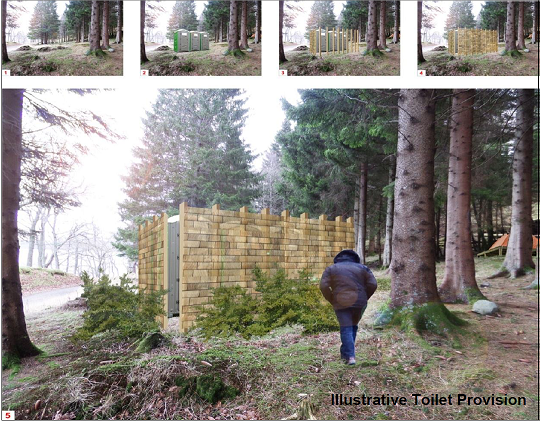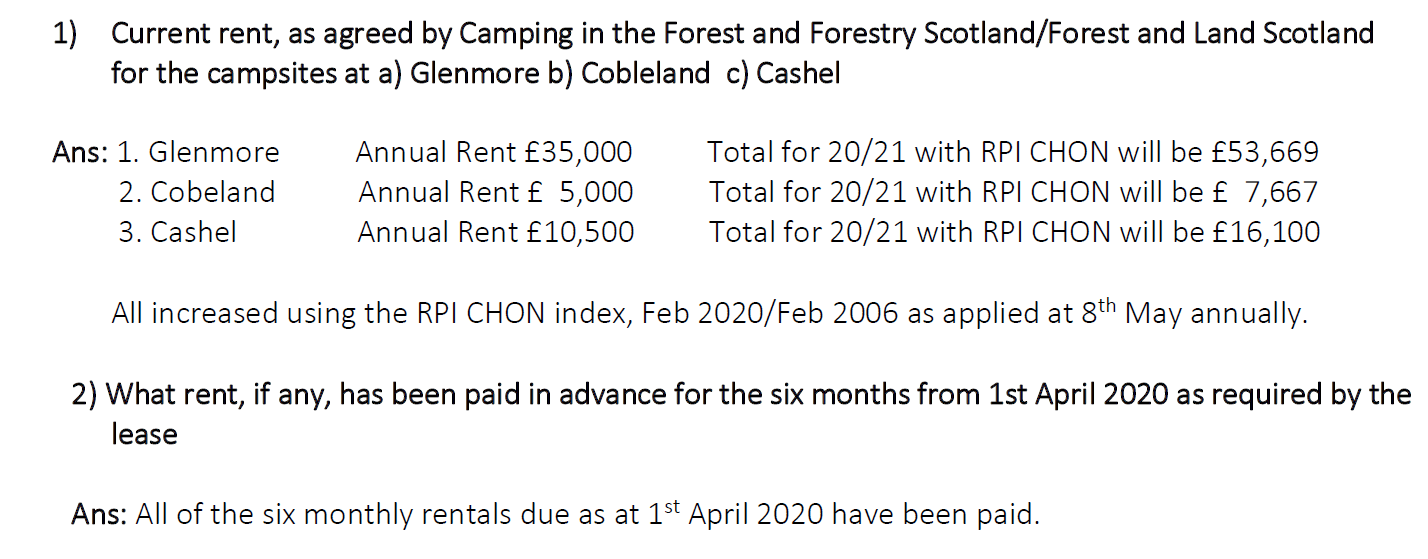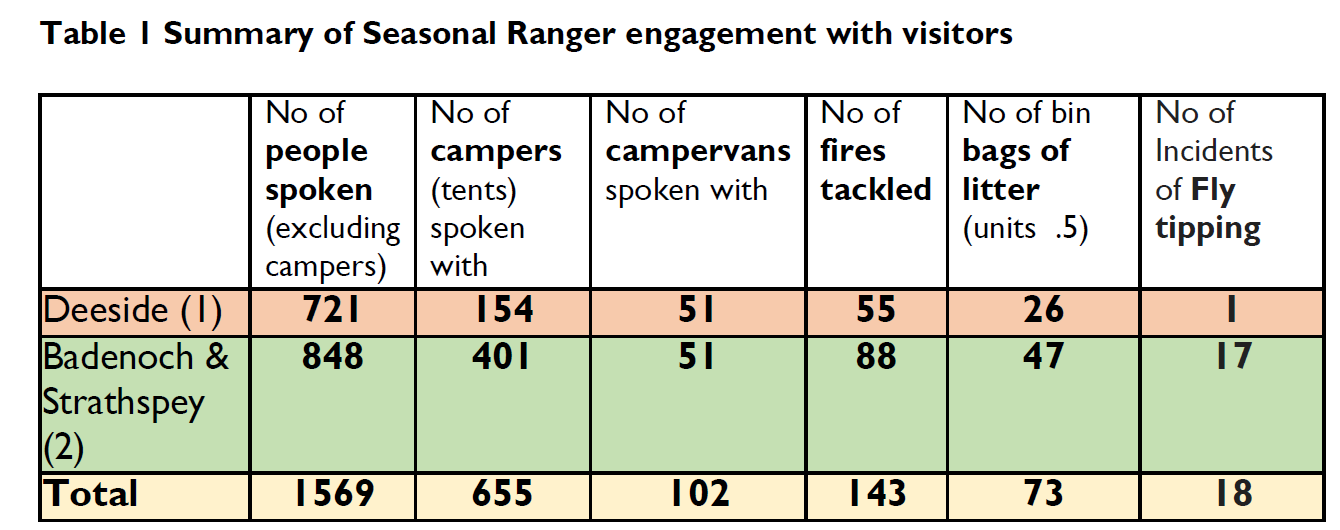The Scottish Parliament this afternoon debates a motion (see here) by Murdo Fraser on Dirty Camping, just the second members’ debate since the start of the corona crisis. While the Scottish Parliament increasingly appears to have little real power, what is said today could still be very important for framing any debate on camping and campervanning going forward.
The question at stake is whether Scotland invests in the type of countryside infrastructure designed to support visitors that is common across the rest of Europe or whether alternatively government tries to restrict access rights and people’s rights to stop off overnight in vehicles by the road. This post takes a look at what can be learned from what has been happening in our two National Parks recently.
How successful are camping permit areas?
Murdo Fraser’s motion, based on what is happening in Perth and Kinross, suggests that consideration should be given to the introduction of “permit” areas. At the beginning of July Perth and Kinross Council officers recommended against any approach which would require byelaws (see here):
- Byelaws require significant ongoing resources to monitor and enforce. Camping byelaws require official campsites to be established, and operated (including charging). Again we do not have the resources to establish and operate these services.
- Even for areas that do have bye-laws (eg Loch Lomond & Trossachs National Park), there have been ongoing problems with dirty camping and anti-social behaviour
That Perth and Kinross officers were right was shown at the end of last week when the Loch Lomond and Trossachs National Park Authority officially admitted to having had to close permit area B, on the south shore of Loch Earn
“A camping permit area was recently temporarily closed on South Loch Earn in the interests of public health [i.e because of the levels of human excrement] until significant amounts of human waste could be safely uplifted from the permit areas.” (Extract from Board Paper for 14th September item 5 (see here)
The LLTNPA’s camping byelaws and permit areas were introduced on the grounds that they would solve the problems associated with some campers in the National Park. In the LLTNPA’s three year review to Scottish Ministers there was an admission that some permit areas had seen problems getting worse, not better. Unfortunately, instead of the Scottish Government inquiring into whether the camping byelaws had been effective they endorsed the camping byelaws in a letter issued to the LLTNPA in July, but only published last week (see here). Noticeable by its absence in the Review submitted to Scottish Ministers was any cost benefit analysis. The LLTNPA had promised their camping “stakeholder group” this be included in the report.
In the case of the south shore of Loch Earn, the original plan was to provide a toilet block in the woods to support the campers who would be concentrated there by the byelaws.

Those plans, while never adequate for c6km of shoreline, were then quietly dropped. The Park’s message (see here) now to all visitors, not just campers, is:

“Go before you”, a completely useless message for most people but particularly those staying overnight. The consequences of permit areas without loos are predictable and increased demand has exposed this and led to the decision to close, even if only temporarily, the Loch Earn camping permit area.
Almost any other National Park in Britain, indeed the world, would have installed some toilet provision years ago. It is extraordinary that when, under public pressure and as a result of certain toilets being out of commission, the LLTNPA agreed to supply some mobile toilets to help with the release of lockdown, the Park’s senior management failed to make provision for South Loch Earn and similar places. Some work, I understand, is now being undertaken to provide mobile toilets at Loch Earn, too late for the staff who are now working on the clear-up. That is a horrible job that should and could have been avoided.
In their report to Scottish Ministers on the review of the camping byelaws in March 2020 the LLTNPA reported “As of 2019, a total of 327 camping spaces were available within the Camping Management Zones”. Setting aside the fact that that those “camping places” include unserviced places for campervans, and that some of those allocated for camping are totally unsuitable for the purpose, the LLTNPA has now clearly failed to deliver the promise it made to Scottish Ministers in 2014 to provide 300 camping places and add to this year on year. Loch Earn is not the only example since lockdown was lifted of camping places being removed by the LLTNPA from use. The Loch Achray campsite, for example, was for a time unavailable due to flooding. (The LLTNPA was warned about this at the time it was considering the planning application, not just by myself but by SEPA, but chose to ignore that advice and has now reaped the consequences without having any alternatives in place). At a time when demand for camping is higher than ever before, the LLTNPA should have been increasing the number of permit places where people could camp lawfully but instead has been removing them.
The inevitable consequence of restricting numbers camping around the lochs in the National Park has always been to displace people elsewhere. By cutting places – in August there were regular reports of all permit areas being fully booked – the LLTNPA has made the displacement problem even worse. In their report to Scottish Ministers they claimed “that there is currently very little direct or anecdotal evidence of displacement being caused by the byelaws”. If that was right, the disastrous consequence of the byelaws would have been more people staying at home. Ann Widdop, who set up Stop Trashing Scotland spoke the truth on Call Kaye (see here) when she directly attributed a proportion of the problems being experienced at Arisaig to the displacement effect of the camping byelaws and the lack of visitor infrastructure. The point is that the LLTNPA, which has been extremely well resourced by Scottish Ministers, instead of setting an example of how to manage visitors and the infrastructure needed to do this, has been shunting issues elsewhere in the Highlands to public authorities who have nothing like the same resources to manage the issues.
The wider problem illustrated by the Loch Earn permit area is that instead of addressing issues through the provision of infrastructure, the LLTNPA has been trying to make them go away by removing visitor infrastructure and trying to persuade/force visitors to stay away: closed permit areas, closed roads, closed car parks and removal of litter bins.
Camping in the Forest
As if the reduction of the LLTNPA’s camping places wasn’t bad enough, three campsites operated by Camping in the Forest in Glen More (206 pitches), Cashel, East Lomond (168 pitches) and Coberland, Aberfoyle (126 pitches) remain closed. After my post on the scandal at Glen More (see here) I paid to obtain a copy of Forest and Land Scotland’s lease with Camping in the Forest from the Registers of Scotland (see here).
The lease was agreed in 2006 for 75 years – an extraordinary period of time. It appears hopelessly inadequate for the current circumstances containing no requirements for Camping in the Forest to keep the campsite open at all times. As a consequence this lease – and the others for Cobeland and Cashel which are likely to be similar – may be very hard to terminate. Ultimate responsibility for this mess lies with the Lib-Lab government of the time and the neo-liberal ideology that public assets would be better managed by the private sector without any thought of the potential consequences. That is not the fault of the current Minister, Fergus Ewing, but it is now up to him to sort out the mess.
The Scottish Government has, however, made the problem worse by agreeing to apply 100% relief to all business rates following the example of the UK Government early in the Covid crisis. The current rateable value of the Glenmore campsite is £64,000 and had it had to pay this, there might have been an incentive for Camping in the Forest to re-open its sites. I say “might” because another Freedom of Information request to Forestry and Land Scotland (see here) revealed that Camping in the Forest has paid all rents due for 2020/21:

Camping in the Forest therefore appear, being able it seems to pay the rents due on all 16 UK campsites without any income. That raises further questions about whether the leases offer value for money. One might also reasonably ask about why the rent for Cashel, 168 places, is so much lower than that for Glenmore with its 206 places? It is not just that these facilities, if opened, could significantly help reduce current pressures on our two National Parks. If owned and managed for the common good, they could also potentially bring in some much needed income for investment in local tourist infrastructure.
What’s been happening in the Cairngorms
Even though the closure of Cashel must have created huge problems for walkers who have flocked to the West Highland Way since lockdown, there is not a mention of this in the LLTNPA report on visitor management to their Board meeting on Monday (see here). By contrast, the Cairngorms National Park Authority is very open about the problems in Glen More caused by the closure of the campsite there stating:
“the failure to get the Camping in the Forest site open at Glenmore…… caused extreme pressure on the area and it is disappointing that this could not be rectified”.
The CNPA appears to understand the link between provision of infrastructure and visitor management “problem”s.
As well as Glenmore, the biggest infrastructure issue the CNPA has identified is “the lack of facilities to deal with the influx of campervans especially waste“. Their senior management have committed to to try and address this for next year.
The data on camping and other visitor management issues contained in the appendices to the report (see here) supports this. 70-100 informal campers PER WEEK at key hotspots rather puts the problem of Dirty Camping into perspective. That is just 10-20 tents a night which could be supported with relatively little visitor infrastructure. In most places there is no problem.
The report also contains information that suggests that where there are problems, these are partly caused by (young people) having nowhere to go; “Glen Doll- a disco party with a marquee, abandoned tests, fires, human waste”; “Calvine and Struan – Social gatherings, fires and litter”. That is something we need to look at more across Scotland.

The figure from this chart on bags of litter is striking when compared to those contained in the LLTNPA’s draft Litter Prevention Strategy (see here) :
“Notable examples this season include: Falls of Falloch alone accumulating over 130 bags of litter in the period before travel restrictions were lifted…………………”
That is more than the entire Cairngorms National Park! The conclusion should be obvious, if you don’t provide infrastructure at visitor hotspots like the Falls of Falloch, you are setting yourself up to fail. Instead of trying to blame people for visitor issues, the LLTNPA needs to get Argyll and Bute and Stirling Council to provide litter bins like the Cairngorms National Park local authorities. That would enable them to take a far more balanced approach to visitor management like the CNPA:
“There has been a significant amount of people coming into the Park over the summer. There have also been issues around camping, campervans, human waste, fires, litter and verge parking. These have been especially prevalent at key hotspots. However, it should also be noted that the vast majority of visitors have behaved well, and that many of the issues around fires etc were done through ignorance rather than malice.”
The CNPA have taken on additional rangers and conclude that:
“Overall the approach this summer has been successful and the feedback from residents and visitors has on the whole been very good.”
The contrast to the LLTNPA’s Board Report is striking:
“The transition from full lockdown through the various phases of Scotland’s Route Map easing of restrictions up to the reopening of Scottish tourism on 15th July has been extremely challenging”
The lessons from our two National Parks is that the issue that our politicians and the Scottish Government needs to focus on is not how to control “Dirty Camping” – leave the deliberately antisocial minority to the police – but rather how to provide the infrastructure that enables people to enjoy the countryside.
“That there is currently very little direct or anecdotal evidence of displacement being caused by the bylaws”???????????? So you remove hundreds of people from one area then simply make them vanish like some magic trick the real problem is the people that believe such total and utter nonsense
At the heart of this we have the high costs of administering public spaces which are are a direct consequence of the Uk’s land-fill taxation policy. The aim was to reduce waste and encourage recycling. It has done neither. Today we see the proof of a cheaper option – export of waste to anywhere in the world – cramming containers full of the stuff – to avoid the penalty levels of tax for disposal in UK. A second consequence has been local authorities reluctant to provide disposal points and make it as hard for anyone to actually use the “service points they do provide as possible …As if it is somehow cheaper in the end to deploy council staff, and hope for enough volunteers to tidy up what should have been binned. In the end litter picked up still has to follow the correct disposal route? It does not disappear. The UK land fill taxation ideal lies somewhere at the root of all these issues.
And then we have a magnificent example of what is wrong. One local resident last week very responsibly travelled 50 miles to the Council recycling point with two broken old armchairs ( a mix of materials which should not be burned) for disposal into the crushing container. He was refused access at the gate by hard pressed council staff, with whom he was very sympathetic. They pointed out a “policy issue”. These chairs were regarded as ” bulky goods”. Due to the council’s temporary refusal policy on such large items (a Covid -19 excuse, apparently! ) Disposal point staff could not accept items like furniture . Fortunately for the environment ,this resident was in fact a very responsible person. He conscientiously drove these two derelict chairs the 50 miles back home -they sit here now. . Others might not have arrived home with them… then what? ? Is it not land fill tax and ‘strapped for cash’ Highland area councils being “fined” for overstepping Land fill targets that is the real issue here.?
I predict that the outcome will be more rules and restrictions, not the provision of facilities.
It’s not confined to Scotland. in recent years the local authority in the Peak District has taken the decision to cease operating public toilets, this in one of the prime tourist areas in the country. Fortunately many local communities have taken them on but there have been closures. The consequences are inevitable. The other side of the coin is the way a minority of the public treat such facilities which is why pubs and cafes etc. are reluctant to allow use by non customers. There should be an offense of “Misuse of a Public Lavatory” with draconian penalties to reflect the difficulty of detection.
Councils seem anxious to forget that the provision of public toilets and rubbish disposal is their key function for public health reasons, but it provides no grandstanding opportunities for councillors or officials.
It is strange that no council of any political leaning opposed the landfill tax but all use it as an excuse to reduce and restrict refuse services. As Tom notes, a trip to the tip is likely to result in being turned away for failing to meet one of the ever increasing and changing rules on what may be tipped and what vehicle you may use to do it. No wonder people fly tip – which has increased immensely in this area during lockdown whatever the Council say to the contrary.
Congratulations to Perth and Kinross Council for a well thought out solution to the lifting of lockdown restrictions. The problems experienced in relation to the huge increase of visitors, not just to Perth and Kinross but to all areas that people like to visit, are not going to vanish overnight and could well be on the rise as more people decide to holiday at home. Bringing in measures that could take several months to implement is not the answer. This needs action now. As children are back to school, maybe there could be lessons at school to start addressing the problems? Once upon a time we had the Scout and Girl Guide movements etc, who would be teaching the kind of countryside code, now could be the time for school visits from council staff or park rangers to try and educate a new generation rather than restrict their future freedoms ? Also it may help other councils if the ideas from Perth and Kinross were circulated to them.
They already get these sort of lessons. A look at the streets around any school after lunch break will show how effective they are.